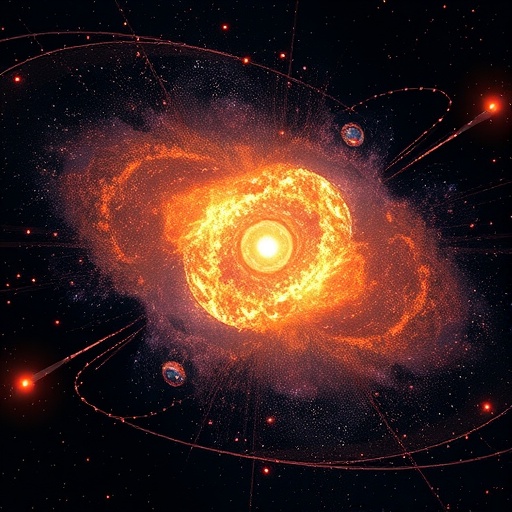A groundbreaking advancement in the modeling of heavy ion collisions has emerged from an international collaboration, with significant contributions from researchers at the University of Jyväskylä in Finland. This cutting-edge research leverages sophisticated computational simulations to probe the interactions underlying one of nature’s most elusive and fundamental phenomena—the quark-gluon plasma (QGP). The studies, anchored in nonlinear quantum chromodynamics (QCD) evolution, shed unprecedented light on the initial conditions and energy dependence of nuclear collisions occurring at near-light speeds.
When two atomic nuclei collide at extremely high energies—approaching the speed of light—a unique and angry state of matter blossoms into existence. In this exotic environment, protons and neutrons dissolve, releasing their constituent quarks and gluons into a hot, dense medium known as the quark-gluon plasma. This plasma is believed to mirror the conditions of the universe microseconds after the Big Bang and holds the key to unlocking the mysteries surrounding the early cosmos and the strong nuclear force that binds the atomic nucleus.
The challenge for physicists has been to understand the initial geometry and energy densities in these collisions, essential prerequisites for interpreting the QGP’s properties. Traditional models have grappled with depicting how the innermost structure of protons and nuclei evolves with collision energy, leaving gaps in our ability to fully decipher experimental observations. The latest research breaks new ground by solving complex nonlinear QCD evolution equations, capturing the dynamic internal rearrangement of gluons—the carriers of the strong force—inside nuclei as energy scales shift.
By refining these models, researchers achieved striking concordance with particle production patterns measured in experiments at Brookhaven National Laboratory (BNL) and CERN. The simulations’ enhanced ability to reproduce these empirical signatures provides a sharper, more detailed picture of the QGP’s formation and subsequent development. This progress bridges the divide between theory and experiment, offering a more precise framework for extracting physical properties such as temperature, viscosity, and expansion dynamics of the quark-gluon plasma.
Heikki Mäntysaari, Associate Professor and prominent theoretical physicist at the University of Jyväskylä, emphasizes that this breakthrough not only improves our grasp of nuclear physics but also echoes cosmic significance. He notes, “Understanding nuclear matter under such extreme conditions enriches our comprehension of the universe’s first moments, right after the Big Bang, propelling our knowledge of fundamental forces to a new level.” Through sophisticated computer simulations, the team charted a detailed blueprint of how the atomic nucleus grows and morphs at escalating energy scales—a critical piece in the QGP puzzle.
This research owes its power to merging theoretical insight with a deep engagement with experimental data. By juxtaposing refined models with results from heavy ion collision detectors, the collaboration offers a convincing narrative of how gluonic fields evolve nonlinearly and influence the observable particle spectra. These advances create fertile ground for future explorations and enhance predictive capabilities vital for upcoming facilities and experiments.
Excitement builds as the scientific community anticipates the imminent launch of the Electron-Ion Collider (EIC) at Brookhaven in the 2030s. The EIC is poised to provide complementary, high-precision measurements that will probe the gluonic structure of matter with exquisite detail. Mäntysaari highlights this facility’s promise, explaining how it will synergize beautifully with current and past data, enabling researchers to unravel finer aspects of QCD evolution and nuclear dynamics.
The University of Jyväskylä stands at the forefront of this research frontier through its world-class Centre of Excellence in Quark Matter, which unites leading theorists and experimentalists. This hub, supported by the Research Council of Finland, exemplifies international collaboration’s potency. Such coordinated efforts are increasingly necessary as experiments grow in complexity, demanding profound theoretical understanding intertwined with practical measurement strategies.
At the core of this endeavor is the quest to decode the strong interaction, one of the four fundamental forces of nature. Unlike electromagnetic or gravitational forces, the strong force operates over subatomic distances and governs the behavior of quarks and gluons, the elemental building blocks of ordinary matter. The nonlinear QCD equations solved in this study reflect the intricate quantum fluctuations and saturation phenomena that shape how these particles distribute and interact inside nuclei during collisions.
The newly developed models provide critical tools for researchers worldwide—not only honing the accuracy of simulations but also fostering new theoretical insights into gluon saturation effects and nonlinear evolution. These phenomena highlight how the density of gluons swells within fast-moving nuclei, reshaping our understanding of hadronic matter under extreme conditions.
As experiments push boundaries, discovering signatures of collective behavior and emergent properties, enhanced computational approaches remain indispensable. The refined modeling framework helps isolate variables that influence QGP characteristics and reduce uncertainties that have long hampered precise measurements. This progress marks a pivotal step toward a comprehensive theory of hot, dense nuclear matter, connecting hundreds of scientific studies into a coherent global effort.
In sum, these advancements represent a quantum leap in our capability to simulate and understand heavy ion collisions, bringing physicists closer to recreating—and interpreting—conditions from the dawn of the universe. This work not only fortifies our knowledge of quantum chromodynamics but also deepens humanity’s grasp of nature’s fundamental fabric, ensuring future research thrives on a robust, informed foundation.
Subject of Research: Not applicable
Article Title: Collision-Energy Dependence in Heavy-Ion Collisions from Nonlinear QCD Evolution
News Publication Date: 10-Jul-2025
Web References: DOI: 10.1103/gf4y-p5j7
Image Credits: Picture: Björn Schenke
Keywords
heavy ion collisions, quark-gluon plasma, quantum chromodynamics, nonlinear QCD evolution, gluon saturation, nuclear matter, early universe, computational modeling, particle physics, strong nuclear force, Brookhaven National Laboratory, CERN, Electron-Ion Collider





